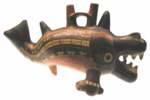- Double spout and bridge vessel
-
 Huaco figurative vessel of this form
Huaco figurative vessel of this form
The double spout and bridge was a form of usually[1] ceramic drinking vessel developed sometime before 500 BC by Indigenous peoples of the Americas groups on the Peruvian coast.[2] True to its name, this type of bottle is distinguished by two spouts with a handle bridging them. First used by the Paracas culture, it was later adopted by the Nazca. While at first the Paracas tended to incise designs derived from the art of the Chavin culture on the surface of the vessels,[3] later on they began to treat the vessel as a sculptural form, an advance facilitated by developments in ceramic technology that allowed them construct vessels with thinner walls.[4] This tradition was continued by the Nazca, whose vessels were elaborately figurative (see illustration below right), decorated with polychrome glazes, or both.
The vessels were constructed by the coil method. The Nazca would then apply multicolored slip to achieve polychrome effects before the vessels were fired, an advance over the Paracas, who had painted the vessels with resins after firing. The Nazca technique allowed for much brighter and more permanent colors, whose sheen was enhanced by burnishing after the vessel was fired.[5]
Both the Paracas and the Nazca appear to have used this type of vessel for ritual purposes, as they are most often found in graves.[5]
See also
- Stirrup spout vessel
- Bridge spouted vessel, a similarly named but unrelated Mediterranean vessel form
References
- ^ There are a few late silver examples, such as the one illustrated here
- ^ "Whistling bottle with feline face [Peru; Paracas (62.266.72)".] In Heilbrunn Timeline of Art History. New York: The Metropolitan Museum of Art, 2000–.(October 2006) Retrieved 11 May 2009
- ^ Covered Double Spout and Bridge Vessel, 800-100 B.C. Entry on the website of the LACMA retrieved 11 May 2009
- ^ "Gourd bottle [Peru; Topará (63.232.55)".] In Heilbrunn Timeline of Art History. New York: The Metropolitan Museum of Art, 2000–. (October 2006) Retrieved 11 May 2009
- ^ a b Double spout and bridge vessel with hummingbirds, on the Website of the British Museum. Retrieved 11 May 2009. Slip firing fuses the pigmented minerals with the clay itself, while resin simply sat on the surface, and as an organic material was subject to decay
Categories:- Drinkware
- Pre-Columbian art
- Pre-Columbian pottery
Wikimedia Foundation. 2010.

